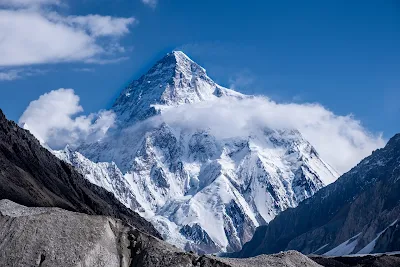Pakistan is home to some of the highest and most majestic mountain ranges in the world, and its highest peak, K2, is known as the "Savage Mountain" for its challenging and dangerous terrain.
Located in the Karakoram mountain range in Gilgit-Baltistan, an autonomous territory in northern Pakistan, K2 stands at an elevation of 8,611 meters (28,251 feet) and is the second-highest mountain in the world, after Mount Everest. Despite its imposing height and treacherous conditions, K2 has long been a coveted prize for experienced climbers and has been successfully ascended by many expeditions over the years.
The history of K2 is closely tied to the history of mountaineering in Pakistan. The mountain was first surveyed by a British expedition in 1856, but it was not until the 20th century that serious attempts were made to reach the summit. In 1902, an Italian expedition led by the Duke of the Abruzzi attempted to climb K2, but they were unable to reach the summit due to the difficult and rocky terrain.
It wasn't until 1954 that K2 was finally conquered when an Italian team led by Ardito Desio reached the top of the mountain. Since then, K2 has been climbed by numerous expeditions, but it remains one of the most challenging and dangerous mountains in the world to climb.
The dangers of K2 are numerous and well-known. The mountain is known for its steep and rocky terrain, which can make it difficult for climbers to gain a foothold. In addition, K2 is located in a region that is prone to extreme weather conditions, including high winds, heavy snowfall, and temperatures that can drop well below freezing.
Despite these challenges, K2 continues to attract experienced climbers from around the world who are drawn to its rugged beauty and the sense of accomplishment that comes with conquering such a formidable peak. However, the risks involved in climbing K2 are also very real, and many climbers have lost their lives attempting to reach the summit.
In addition to K2, Pakistan is home to a number of other high peaks, including Nanga Parbat, which is the ninth-highest mountain in the world and the westernmost peak of the Himalayas. Nanga Parbat, which means "Naked Mountain" in Sanskrit, is located in the Diamer District of Gilgit-Baltistan and stands at an elevation of 8,126 meters (26,660 feet).
Other notable mountains in Pakistan include Gasherbrum I and II, which are part of the Karakoram range and are located in Gilgit-Baltistan. Gasherbrum I, also known as K5, is the eleventh-highest mountain in the world and stands at an elevation of 8,080 meters (26,510 feet). Gasherbrum II, or K4, is the thirteenth-highest mountain in the world and has an elevation of 8,035 meters (26,362 feet).
Broad Peak is another high peak in Pakistan, located in the Karakoram range in Gilgit-Baltistan. It stands at an elevation of 8,047 meters (26,400 feet) and is the twelfth-highest mountain in the world. Makalu, the fifth-highest mountain in the world, is located on the border between Nepal and China, but a portion of it is also within Pakistan.
Pakistan's high mountains are a source of pride for the country and have long been a source of fascination for adventurers and climbers from around the world. These towering peaks are a testament to the natural beauty and ruggedness of the region, and their challenges have attracted some of the most skilled and experienced climbers in the world.
